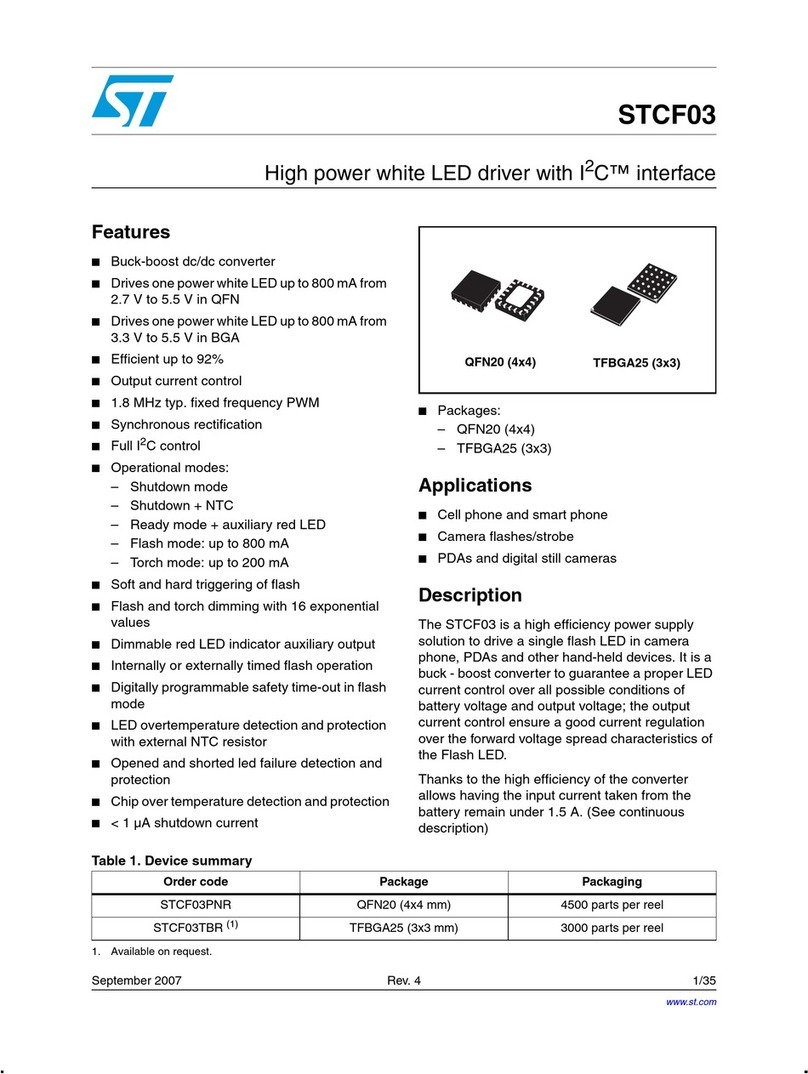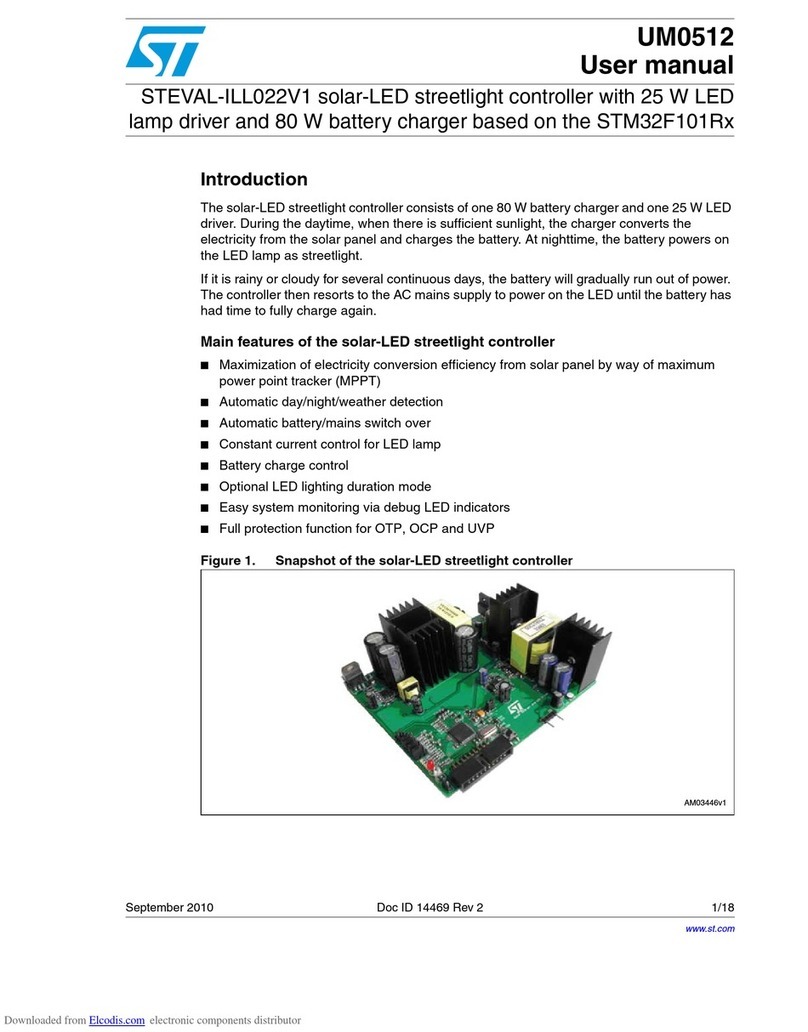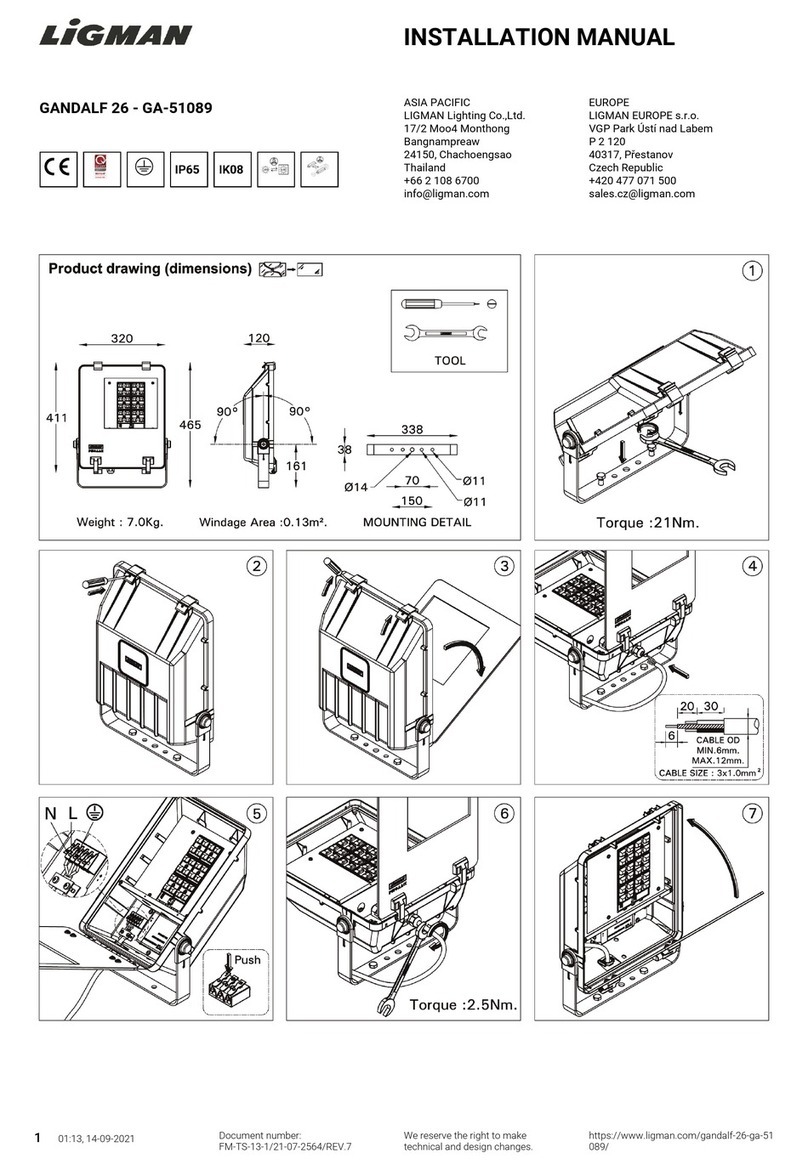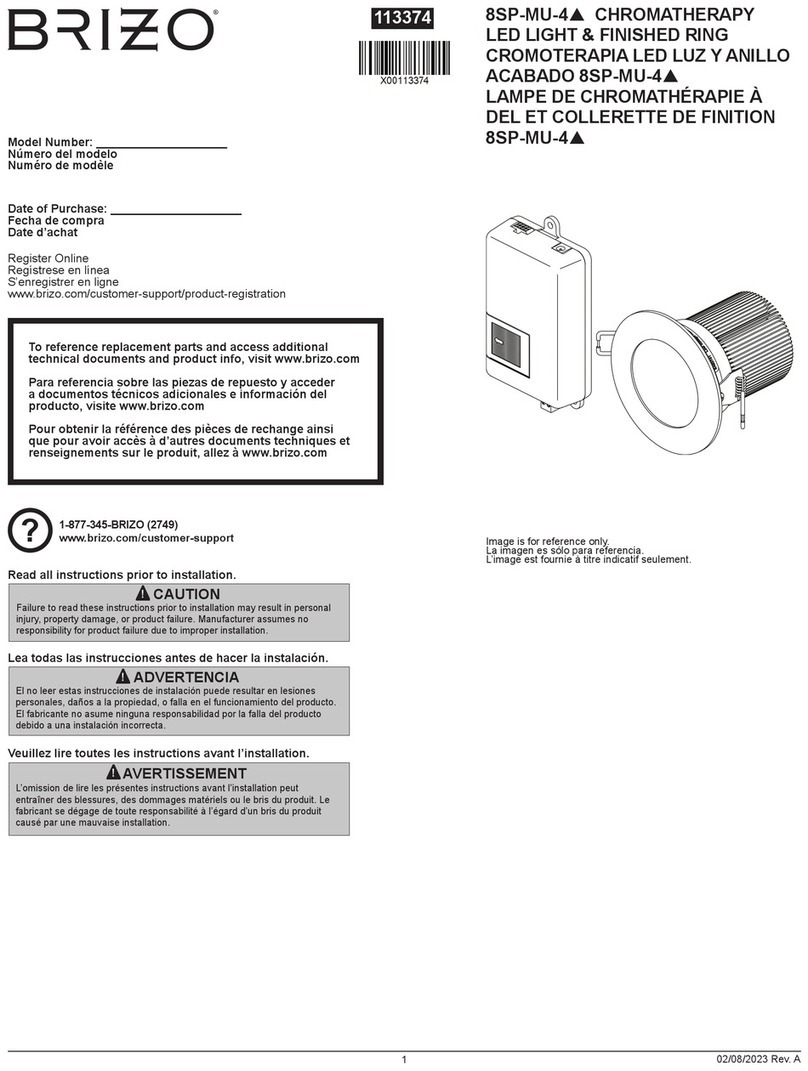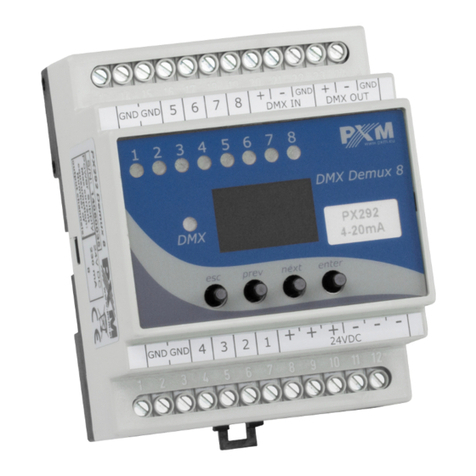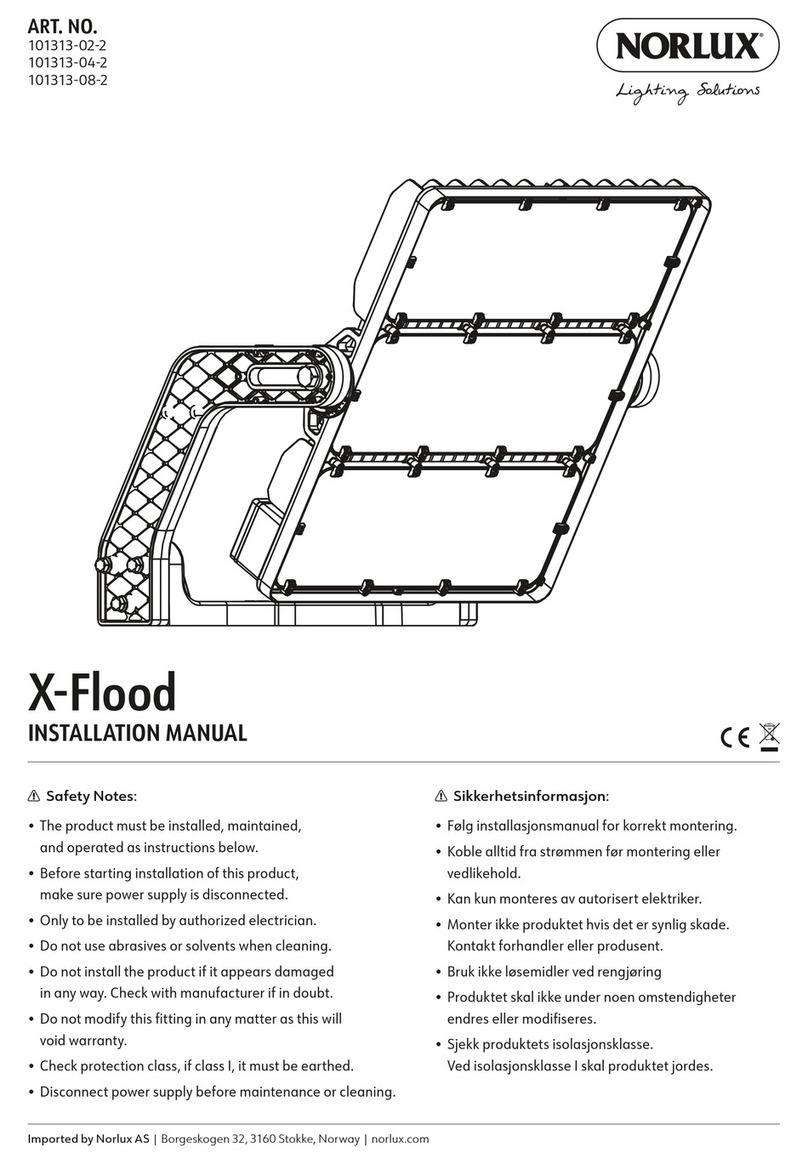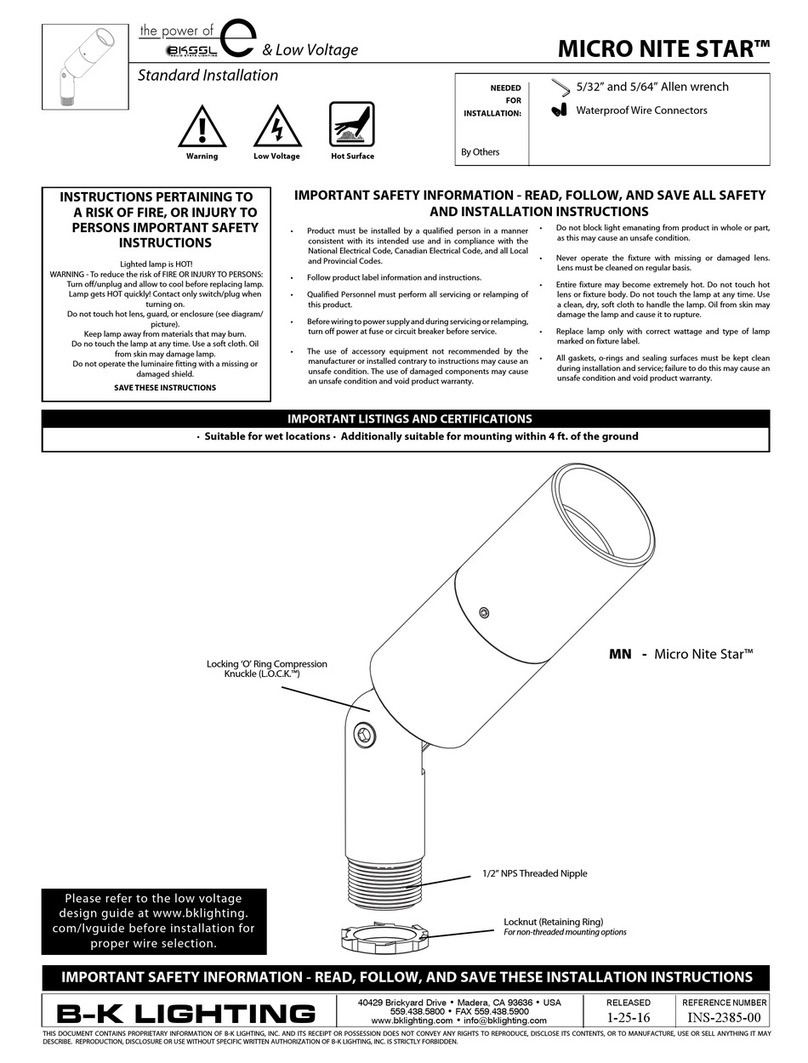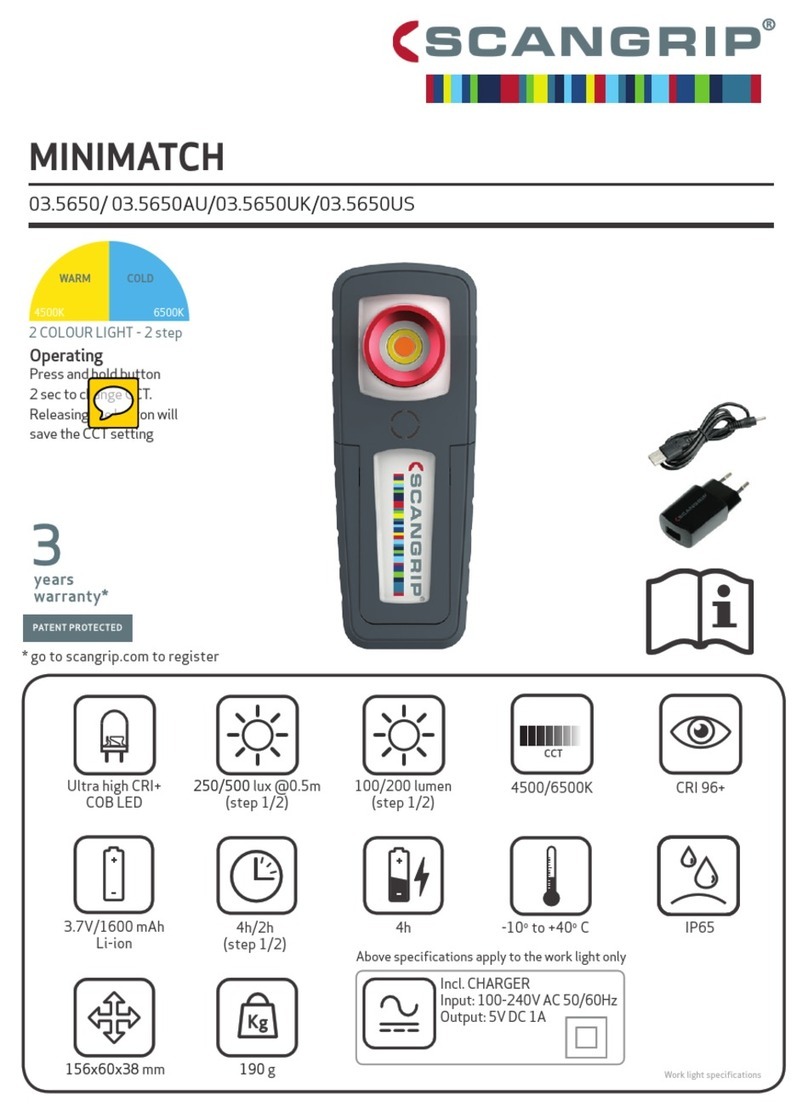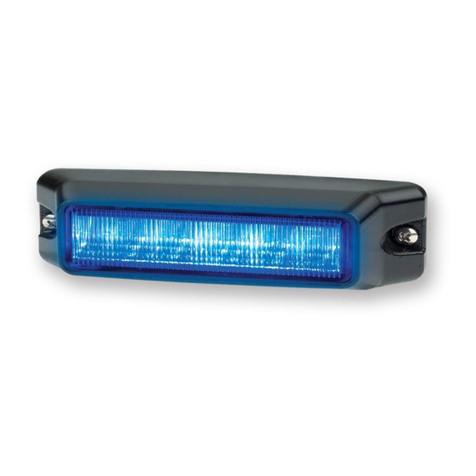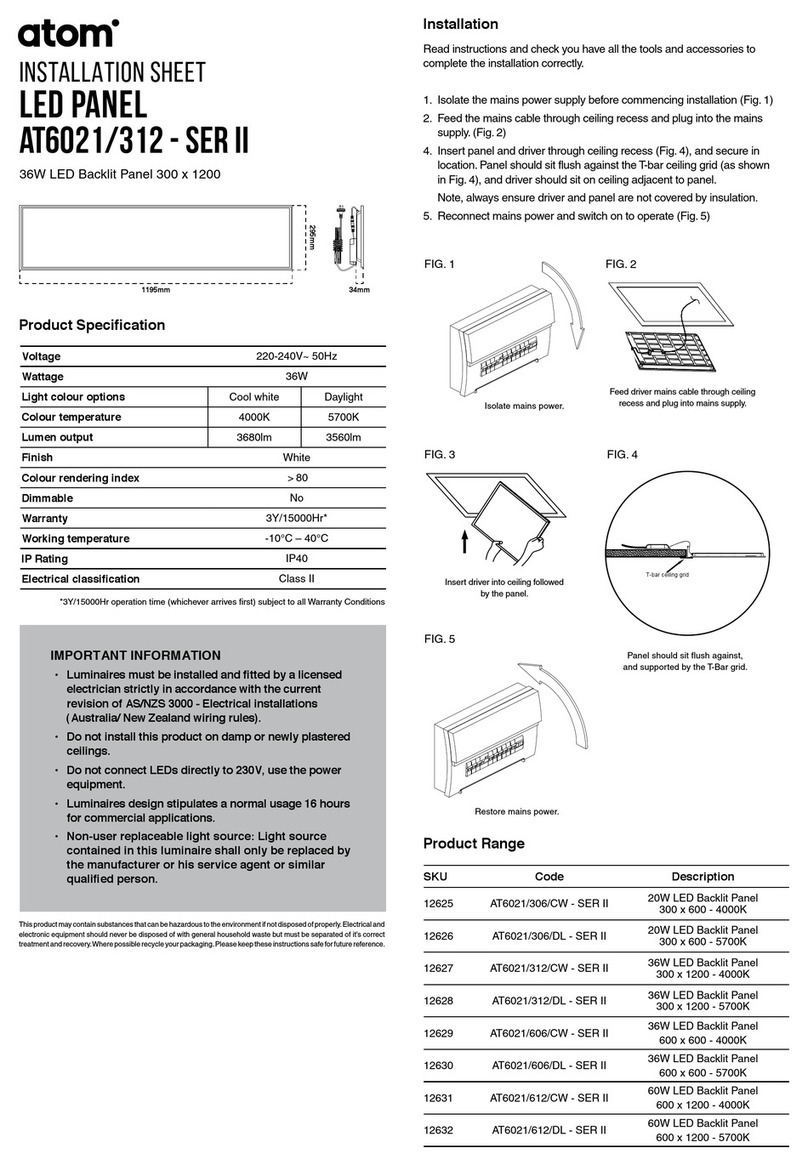STMicroelectronics STP1612PW05 User manual

Preliminary data
This is preliminary information on a new product now in development or undergoing evaluation. Details are subject to
change without notice.
December 2009 Doc ID 15819 Rev 4 1/35
35
STP1612PW05
16-channel LED driver with 16-bit PWM,
8-bit gain and full LED error detection
Features
■16 constant current output channels
■Supply voltage: 3.3 V or 5 V
■Two PWM selectable counters 12/16-bit of
grayscale
■Selectable enhanced PWM for ghost effect
reduction
■Open and short LED detection
■8-bit current gain control by means of 256
steps in two selectable ranges
■Single resistor to set the current from 3 mA to
60 mA
■Programmable progressive output delay
■Thermal protection and thermal flag
■UVLO
■Schmitt trigger input
■Selectable 16-bit or 256-bit serial data-in
format
■Max clock frequency: 30 MHz
■ESD protection 2.5 kV HBM, 200 V MM
■Drop-in compatible with STP16CP\S\DP05
series
■Available in high thermal efficiency TSSOP
exposed pad
Applications
■Video display LED panels
■RGB backlighting
■Special lighting
Description
The STP1612PW05 is a 16-channel constant
current sink LED driver. The maximum output
current value for all the 16 channels is set by a
single resistor from 3 mA to 60 mA. The device
features 8-bit gain (256 steps) for global LED
brightness adjustment with two selectable ranges.
This function is accessible via a serial interface.
The device has an individual adjustable PWM
brightness control for each output channel. The
PWM counters are selectable via a serial
interface with 4096 or 65536 steps (12 or 16 bit).
The STP1612PW05 also provides enhanced
pulse-width modulation counting algorithms called
e-PWM to reduce flickering effects (ghost visual
effects) improving the overall image quality. The
device has a dual size 16-bit or 256-bit shift
register. All the control and the shift register read
back data are accessible via serial interface. The
STP1612PW05 has the capability to detect open
and short LED failure and overtemperature,
reporting the status through SPI line. The device
guarantees a 20 V output driving capability,
allowing the user to connect more LEDs in series.
SO-24
TSSOP24 TSSOP24
exposed pad
QFN-24
Table 1. Device summary
Order code Package Packaging
STP1612PW05QTR QFN-24 4000 parts per reel
STP1612PW05MTR SO-24 1000 parts per reel
STP1612PW05TTR TSSOP24 2500 parts per reel
STP1612PW05XTTR TSSOP24 exposed pad 2500 parts per reel
www.st.com

Contents STP1612PW05
2/35 Doc ID 15819 Rev 4
Contents
1 Block diagram . . . . . . . . . . . . . . . . . . . . . . . . . . . . . . . . . . . . . . . . . . . . . . 4
2 Summary description . . . . . . . . . . . . . . . . . . . . . . . . . . . . . . . . . . . . . . . . 5
2.1 Pin connection and description . . . . . . . . . . . . . . . . . . . . . . . . . . . . . . . . . 6
3 Electrical ratings . . . . . . . . . . . . . . . . . . . . . . . . . . . . . . . . . . . . . . . . . . . . 7
3.1 Absolute maximum ratings . . . . . . . . . . . . . . . . . . . . . . . . . . . . . . . . . . . . . 7
3.2 Thermal data . . . . . . . . . . . . . . . . . . . . . . . . . . . . . . . . . . . . . . . . . . . . . . . 7
3.3 Recommended operating conditions . . . . . . . . . . . . . . . . . . . . . . . . . . . . . 8
4 Electrical characteristics . . . . . . . . . . . . . . . . . . . . . . . . . . . . . . . . . . . . . 9
5 Timing waveform . . . . . . . . . . . . . . . . . . . . . . . . . . . . . . . . . . . . . . . . . . . 13
6 Principle of operation . . . . . . . . . . . . . . . . . . . . . . . . . . . . . . . . . . . . . . . 14
7 Definition of configuration register . . . . . . . . . . . . . . . . . . . . . . . . . . . . 16
8 Grey scales data loading . . . . . . . . . . . . . . . . . . . . . . . . . . . . . . . . . . . . 17
9 Setting the PWM gray scale counter . . . . . . . . . . . . . . . . . . . . . . . . . . . 18
9.1 PWM data synchronization . . . . . . . . . . . . . . . . . . . . . . . . . . . . . . . . . . . . 18
9.2 Synchronization for PWM counting . . . . . . . . . . . . . . . . . . . . . . . . . . . . . 19
10 Error detection conditions . . . . . . . . . . . . . . . . . . . . . . . . . . . . . . . . . . . 20
11 Setting output current . . . . . . . . . . . . . . . . . . . . . . . . . . . . . . . . . . . . . . . 21
12 Current gain adjustment . . . . . . . . . . . . . . . . . . . . . . . . . . . . . . . . . . . . . 22
13 Delay time of staggered output . . . . . . . . . . . . . . . . . . . . . . . . . . . . . . . 23
14 Thermal protection . . . . . . . . . . . . . . . . . . . . . . . . . . . . . . . . . . . . . . . . . 23
15 Time-out alert of GCLK disconnection . . . . . . . . . . . . . . . . . . . . . . . . . 24

Block diagram STP1612PW05
4/35 Doc ID 15819 Rev 4
1 Block diagram
Figure 1. Block diagram
PWM and e-PWM
12/16 bit counter
and SYNC control
Serial interface
UVLO & POR
VDD
GND
SDI
CLK
LE
SDO
Constant current output channels
1----------16
TSD
16-bit
Configuration
Register
Shift register
dual size mode
(16 or 256 bit)
PWCLK
Dual range gain
7-bit DAC
PWM databuffer
(16x16 bit)
Gradual outputs
delay
CTRL command
and
CTRL logic
Open/short
error detection
R-EXT

STP1612PW05 Summary description
Doc ID 15819 Rev 4 5/35
2 Summary description
Table 2. Typical current accuracy at 5 V
Output voltage
Current accuracy
Output current VDD temp.
Between bits Between ICs
≥1.0 ± 1.5% ± 6% 15 to 60 5 V 25 °C
≥0,2 ± 1.5% ± 6% 3 to 15
Table 3. Typical current accuracy at 3.3 V
Output voltage
Current accuracy
Output current VDD temp.
Between bits Between ICs
≥1.0 ± 1.5% ± 6% 15 to 60 3.3 V 25 °C
≥0,3 ± 1.5% ± 6% 3 to 15

Summary description STP1612PW05
6/35 Doc ID 15819 Rev 4
2.1 Pin connection and description
Figure 2. Pin connection
Note: The exposed pad should be electrically connected to a metal land electrically isolated or
connected to ground
14
13
15
16
17
18
5
6
4
3
2
1
8
79101112
23
24 22 21 20 19
CLK
SDI
VDD
R-EXT
SDO
OUT7
OUT4
OUT6
OUT3
OUT2
OUT1
OUT0
LE
OUT8
OUT13
OUT12
OUT11
OUT10
OUT9
OUT5
OUT14
OUT15
PWCLK
GND
Table 4. Pin description
Pin n° Symbol Name and function
1 GND Ground terminal
2 SDI Serial data input terminal
3CLK
Clock input terminal used to shift data on rising edge and carries
command information when LE is asserted.
4 LE Data strobe terminal and controlling command with CLK
5-20 OUT 0-15 Output terminals
21 PWCLK Gray scale clock terminal.
Reference clock for grey scale PWM counter.
22 SDO Serial data out terminal
23 R-EXT Input terminal of an external resistor for constant current programing
24 VDD Supply voltage terminal

STP1612PW05 Electrical ratings
Doc ID 15819 Rev 4 7/35
3 Electrical ratings
3.1 Absolute maximum ratings
Stressing the device above the rating listed in the Ta bl e 5 may cause permanent damage to
the device. These are stress ratings only and operation of the device at these or any other
conditions above those indicated in the operating sections of this specification is not implied.
Exposure to absolute maximum rating conditions for extended periods may affect device
reliability.
3.2 Thermal data
Table 5. Absolute maximum ratings
Symbol Parameter Value Unit
VDD Supply voltage 0 to 7 V
VOOutput voltage -0.5 to 20 V
IOOutput current 60 mA
VIInput voltage -0.4 to VDD V
IGND GND terminal current 1300 mA
fCLK Clock frequency 50 MHz
TJJunction temperature range (1)
1. Such absolute value is based on the thermal shutdown protection.
-40 to + 170 °C
Table 6. Thermal data
Symbol Parameter Value Unit
TAOperating free-air temperature range -40 to +125 °C
TJ-OPR Operating thermal junction temperature range -40 to +150 °C
TSTG Storage temperature range -55 to +150 °C
RthJA
Thermal resistance junction-
ambient (1)
1. According to Jedec standard 51-7B
SO-24 42.7 °C/W
TSSOP24 55 °C/W
TSSOP24(2)
Exposed pad
2. The exposed pad should be soldered directly to the PCB to realize the thermal benefits.
37.5 °C/W
QFN-24 55 °C/W

Electrical ratings STP1612PW05
8/35 Doc ID 15819 Rev 4
3.3 Recommended operating conditions
Table 7. Recommended operating conditions at 25 °C, VDD = 5 V
Symbol Parameter Test conditions Min. Typ. Max. Unit
VDD Supply voltage 3.0 - 5.5 V
VOOutput voltage - 20 V
IOOutput current OUTn 3 - 60 mA
IOH Output current SERIAL-OUT - +1 mA
IOL Output current SERIAL-OUT - -1 mA
VIH Input voltage 0.7 VDD -V
DD V
VIL Input voltage GND - 0.3 VDD V
twLAT LE pulse width
VDD = 3.3 V to 5.0 V
20 - ns
twCLK CLK pulse width 10 - ns
twEN PWCLK pulse width 20 - ns
tSETUP(D) Setup time for DATA 5 - ns
tHOLD(D) Hold time for DATA 5 - ns
tSETUP(L) Setup time for LATCH 5 - ns
fCLK Clock frequency Cascade operation (1)
1. If the device is connected in cascade, it may not be possible achieve the maximum data transfer. Please
considered the timings carefully.
-30MHz

STP1612PW05 Electrical characteristics
Doc ID 15819 Rev 4 9/35
4 Electrical characteristics
TA= 25 °C (Unless otherwise specified)
Table 8. Electrical characteristics (VDD = 5.0 V)
Symbol Characteristics Test conditions Min. Typ. Max. Unit
VDD Supply voltage 4.5 5.0 5.5 V
VOMaximum output
voltage OUT0 ~ OUT15 20 V
IOUT
Output current
VO= 1.2V 5 60 mA
IOH SDO, TA= - 40 ~ 125 °C -8 mA
IOL SDO, TA= - 40 ~ 125 °C 8 mA
VIH
Input voltage
“H” level TA= - 40 ~ 125 °C 0.7 *
VDD VDD V
VIL
Input voltage
“L” level TA= - 40 ~ 125 °C GND 0.3 *
VDD
V
IOH
Output leakage
current VO= 20 V 10 μA
VOL Output voltage
SDO
IOL = + 1.0 mA,
TA= - 40 ~ 125 °C 0.4 V
VOH
IOH = -1.0 mA
TA= - 40 ~ 125 °C
VDD -
0.4 V
dIOUT1
Current skew
(Channel)
IOUT = 10 mA
VO= 1.0 V, Rext = 69 kΩ± 1.5 ± 3.0 %
dIOUT2 Current skew (IC) IOUT = 10 mA
VO= 1.0 V, Rext = 69 kΩ± 3.0 ± 6.0 %
%/dVO
Output current vs.
output voltage
regulation
VO within 1.0 V and 3.0 V,
Rext = 34.7 kΩ @ 20 mA ± 0.1 ± 0.5 % / V
%/dVDD
Output current vs.
supply voltage
regulation
VDD within 4.5 V and 5.5 V ± 1.0 ± 5.0 % / V
VO,TH 0.15 0.20 V
RIN(down) Pull-down resistor LE 150 200 250 kΩ
IDD(off) 1
Supply current
“Off”
Rext = Open,
OUT0 ~ OUT15 = Off 71013
mA
IDD(off) 2
IO = 20 mA,
OUT0 ~ OUT15 = Off 6.6 9.5 12
IDD(off) 3 IO= 60 mA,
OUT0 ~ OUT15 = Off 9 12.7 16.5
IDD(on) 1 Supply current
“On”
IO= 20 mA,
OUT0 ~ OUT15 = On 6.6 9.4 12.2
IDD(on) 2 IO= 60 mA,
OUT0 ~ OUT15 = On 8 11.5 14.9

Electrical characteristics STP1612PW05
10/35 Doc ID 15819 Rev 4
Table 9. Electrical characteristics (VDD = 3.3 V)
Symbol Characteristics Test conditions Min. Typ. Max. Unit
VDD Supply voltage 3.0 3.3 3.6 V
VO
Sustaining voltage at
OUT Ports OUT0 ~ OUT15 20 V
IOUT
Output current
VO= 1.2 V 5 60 mA
IOH SDO, TA= -40 ~ 125 °C-1.0 mA
IOL SDO TA= -40 ~ 125 °C1.0 mA
VIH Input voltage “H” level TA= - 40 ~ 125 °C 0.7 *
VDD
VDD V
VIL Input voltage “L” level TA= - 40 ~ 125 °C GND 0.3 *
VDD
V
IOH Output leakage current VO= 17.0 V 0.5 μA
VOL
Output voltage SDO
IOL = +1.0 mA,
TA= -40 ~ 125 °C 0.4 V
VOH
IOH = -1.0 mA
TA= -40 ~ 125 °C 2.9 V
dIOUT1 Current skew (channel)
IOUT = 10.5 mA,
VO= 1.0 V,
Rext = 69 kΩ at 10 mA
± 1.5 ± 3.0 %
dIOUT2 Current skew (IC)
IOUT = 10.8 mA,
VO = 1.0 V,
Rext = 69 kΩat 10 mA
± 3.0 ± 6.0 %
%/dVO
Output current vs.
output voltage regulation
VOwithin 1.0 V and 3.0 V,
Rext = 34.7 kΩat 20 mA ± 0.1 ± 0.5 % / V
%/dVDD
Output current vs.
supply voltage
regulation
VDD within 3.0 V
and 3.6 V ± 1.0 ± 5.0 % / V
RIN(down) Pull-down resistor LE 150 200 250 kΩ
IDD(off) 1
Supply current “OFF”
Rext = Open,
OUT0 ~ OUT15 = Off 7.2 9.3
mA
IDD(off) 2 IO= 20 mA,
OUT0 ~ OUT15 = Off 8.6 11
IDD(off) 3 IO= 60 mA,
OUT0 ~ OUT15 = Off 11.7 15.2
IDD(on) 1
Supply current “ON”
IO= 20 mA,
OUT0 ~ OUT15 = On 29 37.7
IDD(on) 2
IO= 60 mA,
OUT0 ~ OUT15 = On 31.2 40

STP1612PW05 Electrical characteristics
Doc ID 15819 Rev 4 11/35
Figure 3. Test circuit for electrical characteristics
Table 10. Switching characteristics (VDD = 5.0 V) TA= -40 ~ 125 °C
Symbol Characteristics Conditions Min. Typ. Max. Unit
tSU0
Setup time
SDI - CLK ↑
VDD = 5.0 V
VIH = VDD
VIL = GND
Rext = 460 Ω
VLED = 4.5 V
RL= 152 Ω
CL = 10 pF
C1 = 100 nF
C2 = 10 μF
IO= 20 mA
1 ns
tSU1 LE ↑– DCLK ↑1 ns
tSU2 LE ↓– DCLK ↑5 ns
tH0 Hold time CLK ↑- SDI 3 ns
tH1 CLK ↑- LE ↓7 ns
tPD0
Propagation
delay time
CLK - SDO 30 40 ns
tPD1 PWCLK-OUTn4 (1)
1. Refer to the timing waveform, where n = 0, 1, 2, 3.
100 ns
tPD2 LE – SDO(2)
2. In timing of “read configuration” and “read error status code”, the next CLK rising edge should be tPD2 after
the falling edge of LE.
30 40 ns
tDL1
Stagger delay
time
OUTn4 + 1 (1) 40 ns
tDL2 OUTn4 + 2 (1) 80 ns
tDL3 OUTn4 +3 (1) 120 ns
tw(L)
Pulse width
LE 5 ns
tw( CLK) CLK 20 ns
tw(PWCLK) PWCLK 20 ns
tON Output rise time of output ports 10 ns
tOFF Output fall time of output ports 6 ns
tEDD Error detection minimum duration (3)
3. Refer to Figure 5 on page 13.
1µs
PWCLK
CLK
LE
DDV
EXT-R GND SDO
OUT0
.
.
.
Generator
Function
DDI
VIH
=VDD
VIL
=GND
waveform
inputLogic
SDI
OUT15
OUTI
VIH,VIL
VDD
Rext
IOL
IOH

Electrical characteristics STP1612PW05
12/35 Doc ID 15819 Rev 4
Figure 4. Test circuit for switching characteristics
Table 11. Switching characteristics (VDD = 3.3 V)
Symbol Characteristics Conditions Min. Typ. Max. Unit
tSU0
Setup time
SDI - DCLK ↑
VDD = 3.3 V
VIH = VDD
VIL = GND
Rext = 460 Ω
VLED = 4.5 V
RL= 152 Ω
CL = 10 pF
C1 = 100 nF
C2 = 10 μF
1 ns
tSU1 LE ↑– DCLK ↑1 ns
tSU2 LE ↓– DCLK ↑5 ns
tH0 Hold time CLK ↑- SDI 3 ns
tH1 CLK ↑- LE ↓7 ns
tPD0
Propagation delay
time
CLK - SDO 45 40 ns
tPD1 PWCLK-OUTn4(1)
1. Refer to the timing waveform Figure 4, where n = 0, 1, 2, 3.
120 ns
tPD2 LE – SDO(2)
2. In timing of “read configuration” and “read error status code”, the next CLK rising edge should be tPD2 after
the falling edge of LE.
45 40 ns
tDL1
Stagger delay
time
OUTn4 + 1 (1) 40 ns
tDL2 OUTn4 + 2 (1) 80 ns
tDL3 OUTn4 +3 (1) 120 ns
tw(L)
Pulse width
LE 5 ns
tw(CLK) CLK 20 ns
tw(PWCLK) PWCLK 20 ns
tON Output rise time of output ports 11.6 ns
tOFF Output fall time of output ports 7 ns
tDEC Error detection duration 0.5 1 μs
PWCLK
CLK
LE
DDV
EXT-R GND SDO
OUT0
.
.
.
Generator
Function
DDI
OUT
I
C
L
V
LEDwaveform
inputLogic
SDI
OUT15
1
C
2
C
VIH,VIL
VIH=VDD
VIL=GND
Rext
R
L
R
L
C
L
C
L
VDD

STP1612PW05 Timing waveform
Doc ID 15819 Rev 4 13/35
5 Timing waveform
Figure 5. Timing waveform
PWCLK
PWCLK
PWCLK

Principle of operation STP1612PW05
14/35 Doc ID 15819 Rev 4
6 Principle of operation
Table 12. Control command
Signals combination Description
Command name LE
Number of CLK
rising edge when
LE is asserted
The action after a falling edge of LE
Data latch High 1 Serial data are transferred to the buffers
Global latch High 2 or 3 Buffer data are transferred to the comparators
Read configuration High 4 or 5 Move out “configuration register” to the shift
register
Enable “error
detection” High 6 or 7 Detect the status of each output’s LED
Read “error status
code” High 8 or 9
Move out “error status code” of 16 outputs to
the shift registers
Write configuration High 10 or 11 Serial data are transferred to the
“configuration register”
Reset to 16-bit shift
register length High 12 or 13 Set to 16-bit the shift register length

STP1612PW05 Principle of operation
Doc ID 15819 Rev 4 15/35
Figure 6. Timing diagram
$ATA,ATCH
'LOBAL,ATCH
2EAD#ONFIGURATION
7RITE#ONFIGURATION
,%
3$/
#,+
3$)
0REVIOUS$ATA
...
$
$$ .EXT$ATA
$ $ $ $ $ $ $ $ $ $ $ $ $
-3"
$ $ $
,%
#,+
3$)
3$/
...
0REVIOUS$ATA $ $ $
$
$$ .EXT$ATA
$ $ $ $ $ $ $ $ $ $ $ $ $
-3"
,%
#,+
3$/ 0REVIOUS$ATA
... .... ..
&% $ # " !
,%
3$/
#,+
3$)
0REVIOUS$ATA
..
.
.EXT$ATA
& % $ # " !
& % $

Definition of configuration register STP1612PW05
16/35 Doc ID 15819 Rev 4
7 Definition of configuration register
Configuration register
Default value
MSB LSB
FEDCBA9876543210
MSB LSB
FEDCBA9876543210
X 0 1 11 1 8’b10101011 0 0
Table 13. Configuration register
Bit Attribute Definition Value Function
F Read/Write Shift register
length 0 (default) Shift register length 0 = 16-bit,1 = 256-bit
E Read Thermal error
flag
0 (default) Safe (OK)
1 Over temperature (>150 °C typ.)
D Read/Write
PWM counter:
16-bit or 12-bit 0 (default) To set the gray scale mode (PWM):
0 = 12-bit 1 = 16-bit
C
Read/Write PWM counting
mode selection
00 64 times of MSB(1) 6-bit PWM counting plus once
of LSB(1) 6-bit PWM counting
1. Please refer to “setting the PWM counting mode” section.
01 16 times of MSB 6-bit PWM counting by 1/4
PWCLK plus once of LSB 6-bit PWM counting
B 10 4 times of MSB 6-bit PWM counting by 1/16
PWCLK plus once of LSB 6-bit PWM counting
11 (default) PWM counting
A Read/Write
PWM data
synchronization
mode
0 Auto-synchronization
1 (default) Manual synchronization
9~2 Read/Write Current gain
adjustment
00000000
~
11111111
8’b10101011 (default)
1 Read/Write TSD thermal
shutdown
0 (default) Disable
1 Enable (2) the output channel turn OFF
if TTF > 150 °C
2. Please refer to “TSD” thermal error flag and thermal shutdown “section.
0 Read/Write
Time-out alert of
PWCLK
disconnection
0 (default) Enable (3)
3. Please refer to “time-out alert of PWCLK disconnection” section.
1 Disable

STP1612PW05 Grey scales data loading
Doc ID 15819 Rev 4 17/35
8 Grey scales data loading
The STP1612PW05 is able to manage a gray-scale depth of 12 or 16 bits for each output,
exploiting an e-PWM algorithm.
The bit D of the configuration register is used to select the grey-scale loading. Its value can
be set to “0” for 12 bits or “1” for 16 bits. By default, D is set to “0”.
Loading of the data is performed through the serial input on a dedicated buffer and two
different methods can be used.
With both methods, the first incoming data packet is relative to the output 15; the following
packet is relative to the output 14 and so on up to the output 0.
If F=”0”, when a data packet has been loaded, the latch signal (LE) must become active for
one CLK cycle (data latch). When the last data packet, relative to the output 0, has been
loaded, the latch signal must be active for two CLK cycles (global latch) and all the data will
be transferred to the e-PWM registers starting from the MSB.
If F=”1” all data packets (12 or 16 bits x16) are loaded and then the global latch signal must
be active and all the data will be transferred to the e-PWM registers starting from the MSB.
Figure 7. Full timing for data loading

Setting the PWM gray scale counter STP1612PW05
18/35 Doc ID 15819 Rev 4
9 Setting the PWM gray scale counter
STP1612PW05 provides a 12-bit or 16-bit PWM color depth. Each serial data input will be
implemented according to the e-PWM algorithm.
9.1 PWM data synchronization
STP1612PW05 defines the different counting algorithms that support e-PWM, technology,
(scrambled PWM). With e-PWM, the total PWM cycles can be broken down into MSB (most
significant bits) and LSB (least significant bits) of gray scale cycles, and the MSB
information can be dithered across many refresh cycles to achieve overall same high bit
resolution. STP1612PW05 also allows changing different counting algorithms and provides
the best output linearity when there are fewer transitions of output.
Figure 8. 12-bit e-PWM operation example
PWCLK
PWCLK
PWCLK
PWCLK
PWCLK

STP1612PW05 Setting the PWM gray scale counter
Doc ID 15819 Rev 4 19/35
9.2 Synchronization for PWM counting
The data synchronization between the incoming data flow and the output channels is
managed through the bit A within the configuration register.
If the bit A is set to “0” the device performs itself the data synchronization: when all the new
data are loaded with a “global latch”, the device wait until all the PWM counter completes
the counting cycle before updating them with the new data, at the next CLK rising edge.
Conversely, if bit A is set to “1” (default), the data synchronization is not performed by the
device and is managed by the microcontroller, which has to take care of the data and
signals. If this is not done, there might be artefacts on the output image.
Figure 9. Synchronization for PWM counting
Figure 10. Without synchronization for PWM counting
CLK
PWCLK
CLK
PWCLK

Error detection conditions STP1612PW05
20/35 Doc ID 15819 Rev 4
10 Error detection conditions
The STP1612PW05 can detect open channels (OD) and LED short-circuits (SD).
The detection circuitry performs open- and short-circuit detection simultaneously and the
image quality will not be impacted since the test duration is short (0.5 µs typ).
To perform the open-circuit, short-circuit error detection a channel must be on, the
command “enable error detection” starts the detection. After 0.5 µs (typ) the command “read
error status code” allows to get the status from the serial output (SDO).
Note: Where: IO = the output current programmed by the REXT
, IODEC = the detected output
current in detection mode
Figure 11. Detection circuit
Table 14. Detection conditions (VDD = 3.3 to 5 V temp. range -40 to 125 °C)
SW-1 or
SW-3b
Open line or output short to GND
detected ==> IODEC ≤0.5 x IO
SW-2 or
SW-3a
Short on LED or short to V-LED
detected ==> VO≥2.3 V
16
STP1612PW05
This manual suits for next models
4
Table of contents
Other STMicroelectronics Lighting Equipment manuals

